Intergeneric Hybrid from Jatropha curcas L. and Ricinus communis L.: Characterization and Polyploid Induction
Abstract
1. Introduction
2. Materials and Methods
2.1. Plant Materials
2.2. Intergeneric Hybridization
2.3. Embryo Rescue of the Intergeneric F1 Hybrids
2.4. Morphological Characterization
2.5. DNA Isolation
2.6. Randomly Amplified Polymorphic DNA (RAPD) Marker Analysis
2.7. Polyploidy Induction
2.8. Statistical Analysis
3. Results
3.1. Sexual Intergeneric Hybridization and Embryo Rescue
3.2. Identification of Intergeneric F1 Hybrid Using Morphological Characteristics
3.3. Identification of Intergeneric F1 Hybrid Using RAPD Analysis
3.4. Induction of Polyploids in the Intergeneric Hybrids
4. Discussion
5. Conclusions
Author Contributions
Funding
Conflicts of Interest
References
- Liu, S.; Yin, X.; Lu, J.; Liu, C.; Bi, C.; Zhu, H.; Shi, Y.; Zhang, D.; Wen, D.; Zheng, J.; et al. The first genetic linkage map of Ricinus communis L. based on genome-SSR markers. Ind. Crops Prod. 2016, 89, 103–108. [Google Scholar] [CrossRef]
- Montes, J.M.; Melchinger, A.E. Domestication and breeding of Jatropha curcas L. Trends Plant Sci. 2016, 21, 1045–1057. [Google Scholar] [CrossRef] [PubMed]
- Sujatha, M.; Reddy, T.P.; Mahasi, M. Role of biotechnological interventions in the improvement of castor (Ricinus communis L.) and Jatropha curcas L. Biotechnol. Adv. 2008, 26, 424–435. [Google Scholar] [CrossRef] [PubMed]
- Mukherjee, P.; Varshney, A.; Johnson, T.S.; Jha, T.B. Jatropha curcas: A review on biotechnological status and challenges. Plant Biotechnol. Rep. 2011, 5, 197–215. [Google Scholar] [CrossRef]
- Tudses, N.; Premjet, S.; Premjet, D. Establishment of method for protoplast fusion with PEG-mediated between Jatropha curcas L. and Ricinus communis L. Int. J. Life Sci. Biotechnol. Pharm. Res. 2015, 4, 50–56. [Google Scholar]
- Siripong, P.; Duangporn, P. Induction of mutation in Jatropha Curcas L. by treatment with mitotic inhibitors. Aust. J. Basic Appl. Sci. 2016, 10, 77–85. [Google Scholar]
- Joshi, M.; Mishra, A.; Jha, B. Efficient genetic transformation of Jatropha curcas L. by microprojectile bombardment using embryo axes. Ind. Crops Prod. 2011, 33, 67–77. [Google Scholar] [CrossRef]
- Chan, A.P.; Crabtree, J.; Zhao, Q.; Lorenzi, H.; Orvis, J.; Puiu, D.; Melake-Berhan1, A.; Jones, K.M.; Redman, J.; Chen, G.; et al. Draft genome sequence of the oilseed species Ricinus Communis. Nat. Biotechnol. 2010, 28, 951. [Google Scholar] [CrossRef]
- Anjani, K. Castor genetic resources: A primary gene pool for exploitation. Ind. Crops Prod. 2012, 35, 1–14. [Google Scholar] [CrossRef]
- Laosatit, K.; Mokrong, N.; Tanya, P.; Srinives, P. Overcoming crossing barriers between Jatropha (Jatropha curcas L.) and castor bean (Ricinus communis L.). Crop Breed. Appl. Biotechnol. 2017, 17, 164–167. [Google Scholar] [CrossRef]
- Santos, E.A.; Souza, M.M.; Abreu, P.P.; da Conceição, L.D.H.C.S.; Araújo, I.S.; Viana, A.P.; de Almeida, A.-A.F.; Freitas, J.C.d.O. Confirmation and characterization of interspecific hybrids of Passiflora L. (Passifloraceae) for ornamental use. Euphytica 2012, 184, 389–399. [Google Scholar] [CrossRef]
- Nadeem, M.A.; Nawaz, M.A.; Shahid, M.Q.; Doğan, Y.; Comertpay, G.; Yıldız, M.; Comertpay, G.; Yıldız, M.; Hatipoğlu, R.; Ahmad, F.; et al. DNA molecular markers in plant breeding: Current status and recent advancements in genomic selection and genome editing. Biotechnol. Biotechnol. Equip. 2018, 32, 261–285. [Google Scholar] [CrossRef]
- Banjanac, T.; Siler, B.; Skoric, M.; Ghalawenji, N.; Milutinovic, M.; Bozic, D.; Misic, D. Interspecific in vitro hybridization in genus Centaurium and identification of hybrids via flow cytometry, RAPD, and secondary metabolite profiles. Turk. J. Bot. 2014, 38, 68–79. [Google Scholar] [CrossRef]
- Rodrangboon, P.; Pongtongkam, P.; Suputtitada, S.; Adachi, T. Abnormal embryo development and efficient embryo rescue in interspecific hybrids, Oryza sativa× O. minuta and O. sativa× O. officinalis. Breed. Sci. 2002, 52, 123–129. [Google Scholar] [CrossRef][Green Version]
- Sattler, M.C.; Carvalho, C.R.; Clarindo, W.R. The polyploidy and its key role in plant breeding. Planta 2016, 243, 281–296. [Google Scholar] [CrossRef]
- Rehman, M.; Hansen, J.L.; Zemetra, R.S. Hybrids and amphiploids of Aegilops cylindrica with Triticum aestivum L.: Production morphology and fertility. Pak. J. Biol. Sci. 2006, 9, 1563–1566. [Google Scholar]
- Murashige, T.; Skoog, F. A revised medium for rapid growth and bio assays with tobacco tissue cultures. Physiol. Plant. 1962, 15, 473–497. [Google Scholar] [CrossRef]
- Varshney, A.; Johnson, T.S. Efficient plant regeneration from immature embryo cultures of Jatropha curcas, a biodiesel plant. Plant Biotechnol. Rep. 2010, 4, 139–148. [Google Scholar] [CrossRef]
- Laviola, B.G.; Rosado, T.B.; Bhering, L.L.; Kobayashi, A.K.; de Resende, M.D.V. Genetic parameters and variability in physic nut accessions during early developmental stages. Pesq. Agropec. Bras. 2010, 45, 1117–1123. [Google Scholar] [CrossRef][Green Version]
- Colodetti, T.V.; Christo, L.F.; Martins, L.D.; Rodrigues, W.N.; do Amaral, J.F.T.; Laviola, B.G.; Tomaz, M.A. Differential growth of genotypes of physic nut conditioned by nitrogen fertilization. Am. J. Plant Sci. 2014, 5, 2154–2162. [Google Scholar] [CrossRef][Green Version]
- Bardakci, F. Random amplified polymorphic DNA (RAPD) markers. Turk. J. Biol. 2001, 25, 185–196. [Google Scholar]
- Carvalho, C.R.; Clarindo, W.R.; Praça, M.M.; Araújo, F.S.; Carels, N. Genome size, base composition and karyotype of Jatropha curcas L., an important biofuel plant. Plant Sci. 2008, 174, 613–617. [Google Scholar] [CrossRef]
- Nakkuntod, M.; Senthong, P. Investigation of genetic diversity of physic nut (Jatropha curcas L.) in Thailand using RAPD. NU Sci. J. 2009, 6, 55–65. [Google Scholar]
- Zhao, H.; Chen, F.; Guo, W.; Miao, H.; Li, C.; Fang, W. Intergeneric hybrid of Dendranthema grandiflorum Aoyunhuoju and Ajania pacifica and its taxonomic implications. Acta Phytotax. Sin. 2007, 45, 661–669. [Google Scholar] [CrossRef]
- Tang, F.; Wang, H.; Chen, S.; Chen, F.; Liu, Z.; Fang, W. Intergeneric hybridization between Dendranthema nankingense and Tanacetum vulgare. Sci. Hortic. 2011, 132, 1–6. [Google Scholar] [CrossRef]
- Dinesh, M.R.; Veena, G.L.; Vasugi, C.; Reddy, M.K.; Ravishankar, K.V. Intergeneric hybridization in papaya for ‘PRSV’ tolerance. Sci. Hortic. 2013, 161, 357–360. [Google Scholar] [CrossRef]
- Dinesh, M.R.; Rekha, A.; Ravishankar, K.V.; Praveen, K.S.; Santosh, L.C. Breaking the intergeneric crossing barrier in papaya using sucrose treatment. Sci. Hortic. 2007, 114, 33–36. [Google Scholar] [CrossRef]
- Jayavalli, R.; Balamohan, T.; Manivannan, N.; Govindaraj, M. Breaking the intergeneric hybridization barrier in Carica papaya and Vasconcellea cauliflora. Sci. Hortic. 2011, 130, 787–794. [Google Scholar] [CrossRef]
- Patel, R.G.; Mankad, A.U. In vitro pollen germination-A review. Int. J. Sci. Res. 2014, 3, 304–307. [Google Scholar]
- Rodrigues-Otubo, B.M.; Penteado, M.I.; do Valle, C.B. Embryo rescue of interspecific hybrids of Brachiaria spp. Plant Cell Tissue Organ Cult. 2000, 61, 175–182. [Google Scholar] [CrossRef]
- Shen, X.; Gmitter, F.G.; Grosser, J.W. Immature embryo rescue and culture. In Plant Embryo Culture: Methods and Protocols, 1st ed.; Thorpe, T.A., Yeung, E.C., Eds.; Humana Press: Totowa, NJ, USA, 2011; pp. 75–92. [Google Scholar]
- Siar, S.V.; Beligan, G.A.; Sajise, A.J.C.; Villegas, V.N.; Drew, R.A. Papaya ringspot virus resistance in Carica papaya via introgression from Vasconcellea quercifolia. Euphytica 2011, 181, 159–168. [Google Scholar] [CrossRef]
- Szczerbakowa, A.; Tarwacka, J.; Oskiera, M.; Jakuczun, H.; Wielgat, B. Somatic hybridization between the diploids of S. × michoacanum and S. tuberosum. Acta Physiol. Plant. 2010, 32, 867–873. [Google Scholar] [CrossRef]
- Debbarama, C.; Khanna, V.; Tyagi, W.; Ravi, M.; Meetei, N. Wide hybridization and embryo rescue for crop improvement in Capsicum. Agrotechnology 2013, 11. [Google Scholar] [CrossRef]
- Chen, L.-P.; Wang, Y.-J.; Zhao, M. In vitro induction and characterization of tetraploid Lychnis senno Siebold et Zucc. HortScience 2006, 41, 759–761. [Google Scholar] [CrossRef]
- Ntuli, N.R.; Zobolo, A.M. Effect of water stress on growth of colchicine induced polyploid Coccinia palmata and Lagenaria sphaerica plants. Afr. J. Biotechnol. 2008, 7, 3548–3652. [Google Scholar]
- Castro, M.; Castro, S.; Loureiro, J. Production of synthetic tetraploids as a tool for polyploid research. Web Ecol. 2018, 18, 129–141. [Google Scholar] [CrossRef]
- Ascough, G.D.; Van Staden, J.; Erwin, J.E. Effectiveness of colchicine and oryzalin at inducing polyploidy in Watsonia lepida NE Brown. HortScience 2008, 43, 2248–2251. [Google Scholar] [CrossRef]
- Stanys, V.; Weckman, A.; Staniene, G.; Duchovskis, P. In vitro induction of polyploidy in Japanese quince (Chaenomeles japonica). Plant Cell Tissue Organ Cult. 2006, 84, 263–268. [Google Scholar] [CrossRef]
- Pavlíková, Z.; Paštová, L.; Münzbergová, Z. Synthetic polyploids in Vicia cracca: Methodology, effects on plant performance and aneuploidy. Plant Syst. Evol. 2017, 303, 827–839. [Google Scholar] [CrossRef]
- Sakhanokho, H.F.; Rajasekaran, K.; Kelley, R.Y.; Islam-Faridi, N. Induced polyploidy in diploid ornamental ginger (Hedychium muluense RM Smith) using colchicine and oryzalin. HortScience 2009, 44, 1809–1814. [Google Scholar] [CrossRef]
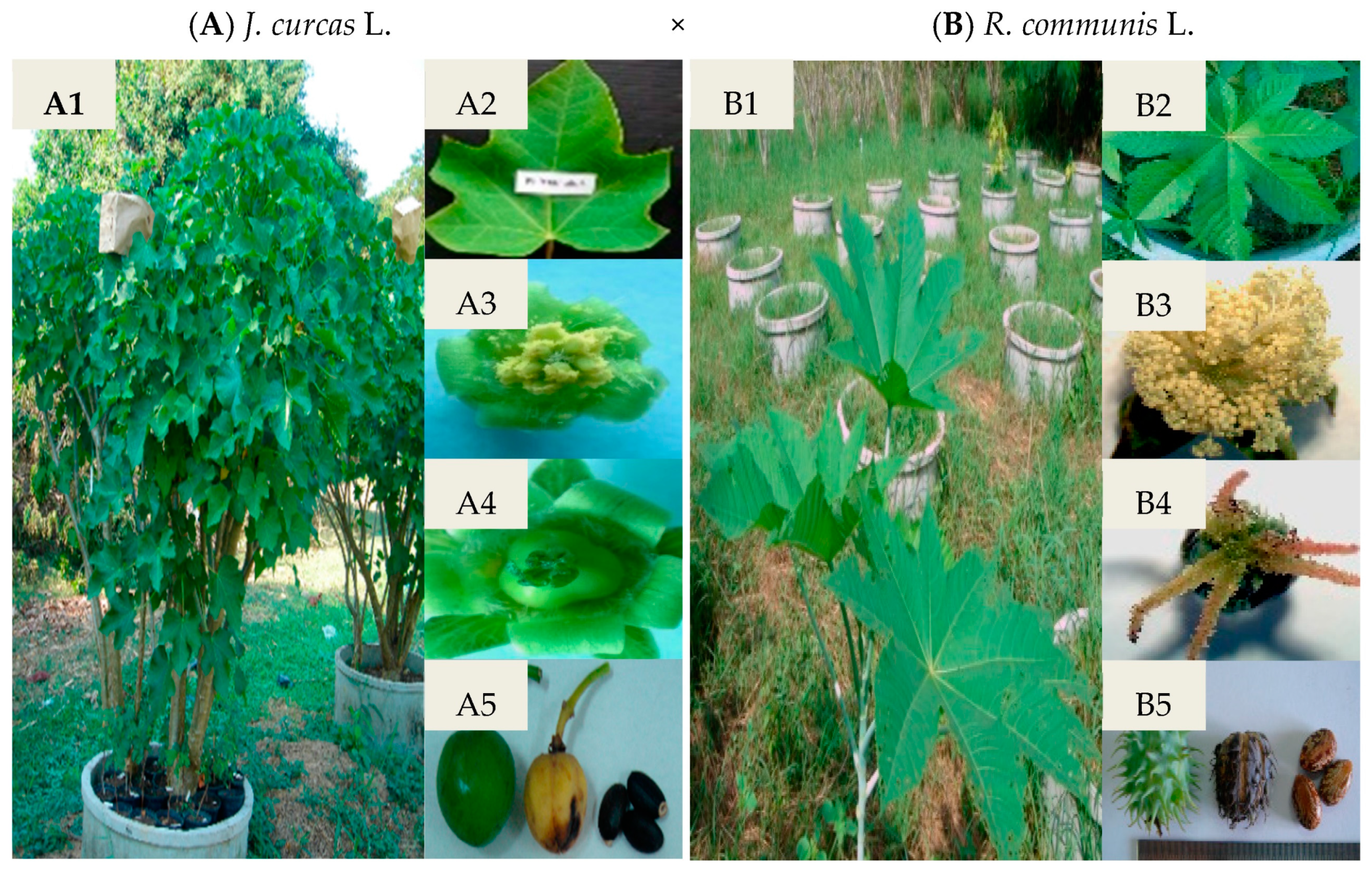
 ) and R. communis L. (
) and R. communis L. ( ), (A) embryo rescue, (B) three-day-old F1 hybrid, (C) transfer of F1 hybrid to small plastic pots containing sterile peat moss, (D) intergeneric hybrid plants in the field, (E) fruits, and (F) seeds.
), (A) embryo rescue, (B) three-day-old F1 hybrid, (C) transfer of F1 hybrid to small plastic pots containing sterile peat moss, (D) intergeneric hybrid plants in the field, (E) fruits, and (F) seeds.
 ) and R. communis L. (
) and R. communis L. ( ), (A) embryo rescue, (B) three-day-old F1 hybrid, (C) transfer of F1 hybrid to small plastic pots containing sterile peat moss, (D) intergeneric hybrid plants in the field, (E) fruits, and (F) seeds.
), (A) embryo rescue, (B) three-day-old F1 hybrid, (C) transfer of F1 hybrid to small plastic pots containing sterile peat moss, (D) intergeneric hybrid plants in the field, (E) fruits, and (F) seeds.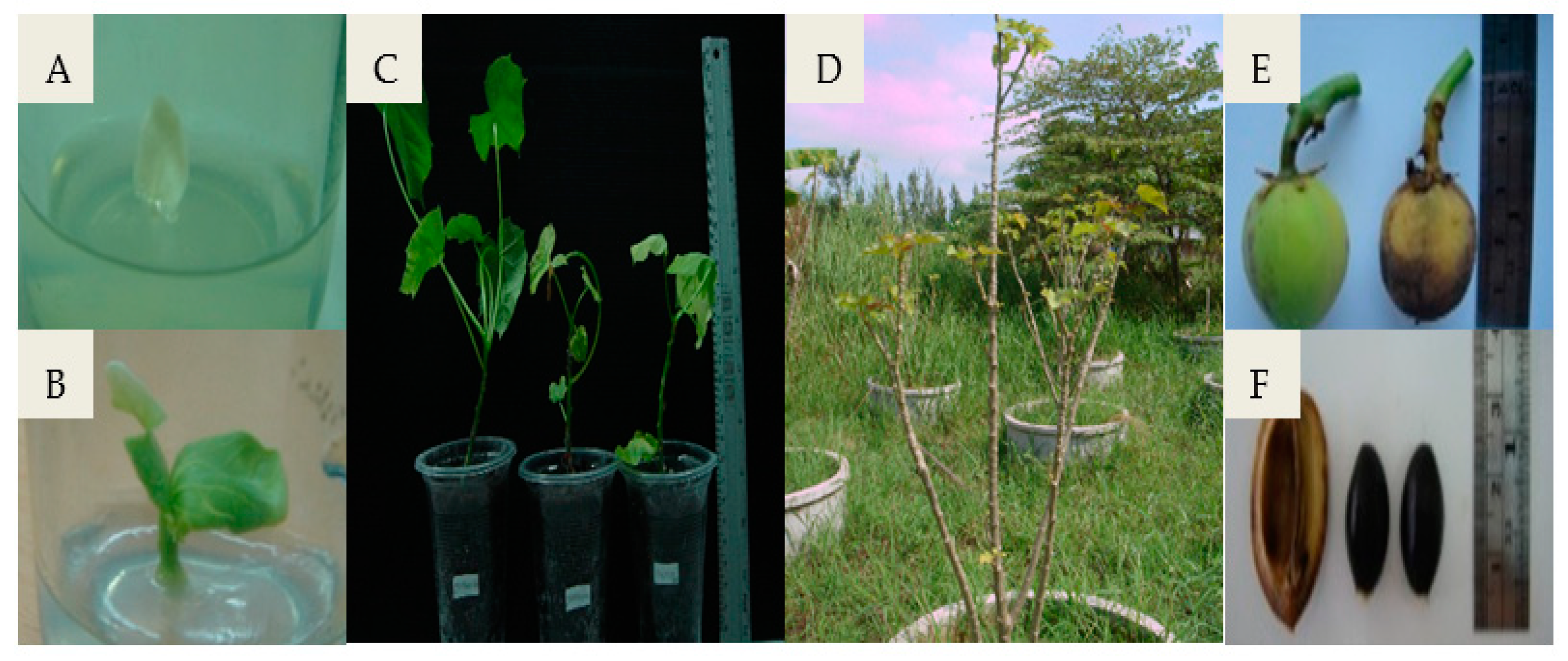
 ) and J. curcas (
) and J. curcas ( ).
).
 ) and J. curcas (
) and J. curcas ( ).
).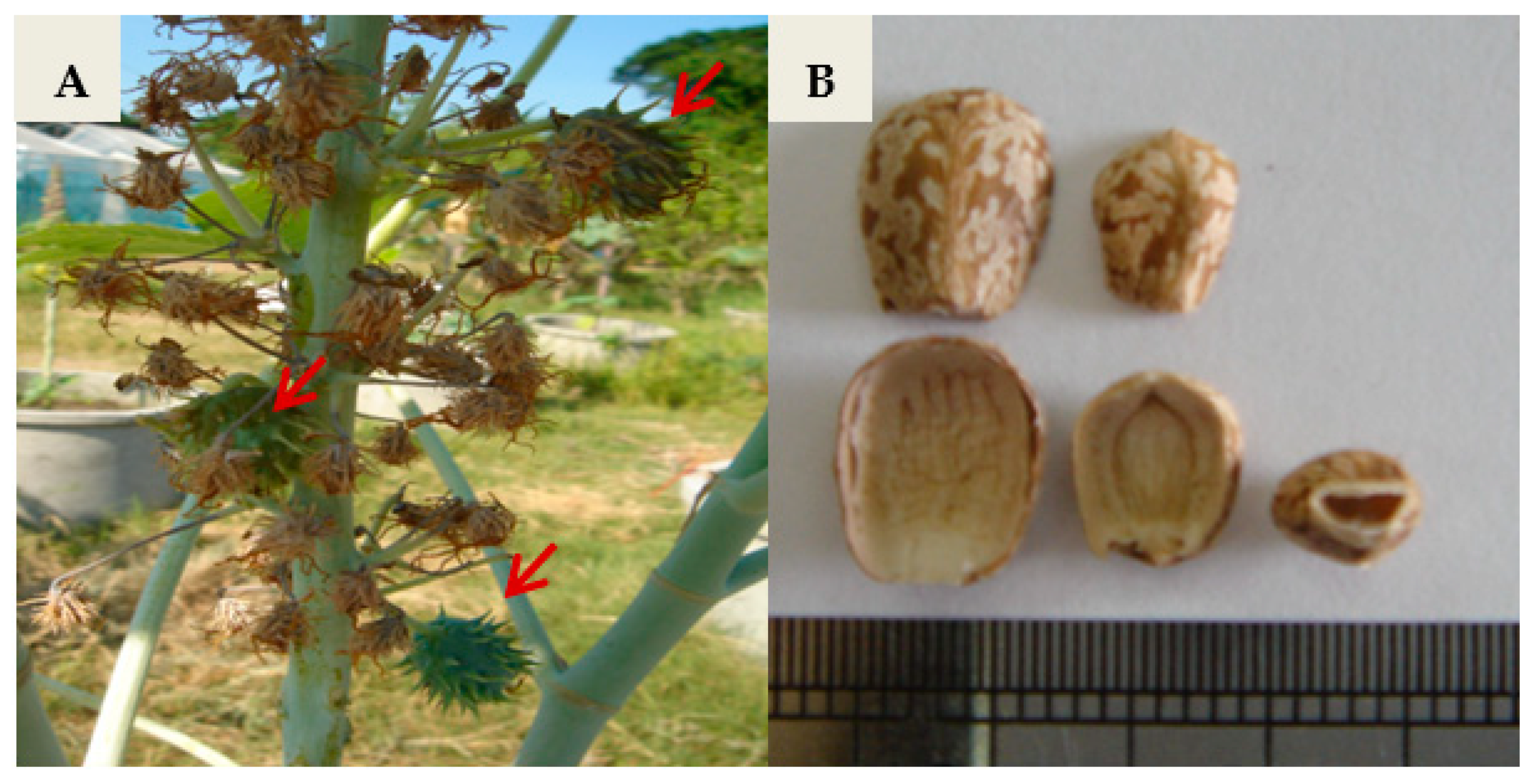
 ) and R. communis (
) and R. communis ( ) including, (A) seeds, (B) seed kernel, and (C) leaf.
) including, (A) seeds, (B) seed kernel, and (C) leaf.
 ) and R. communis (
) and R. communis ( ) including, (A) seeds, (B) seed kernel, and (C) leaf.
) including, (A) seeds, (B) seed kernel, and (C) leaf.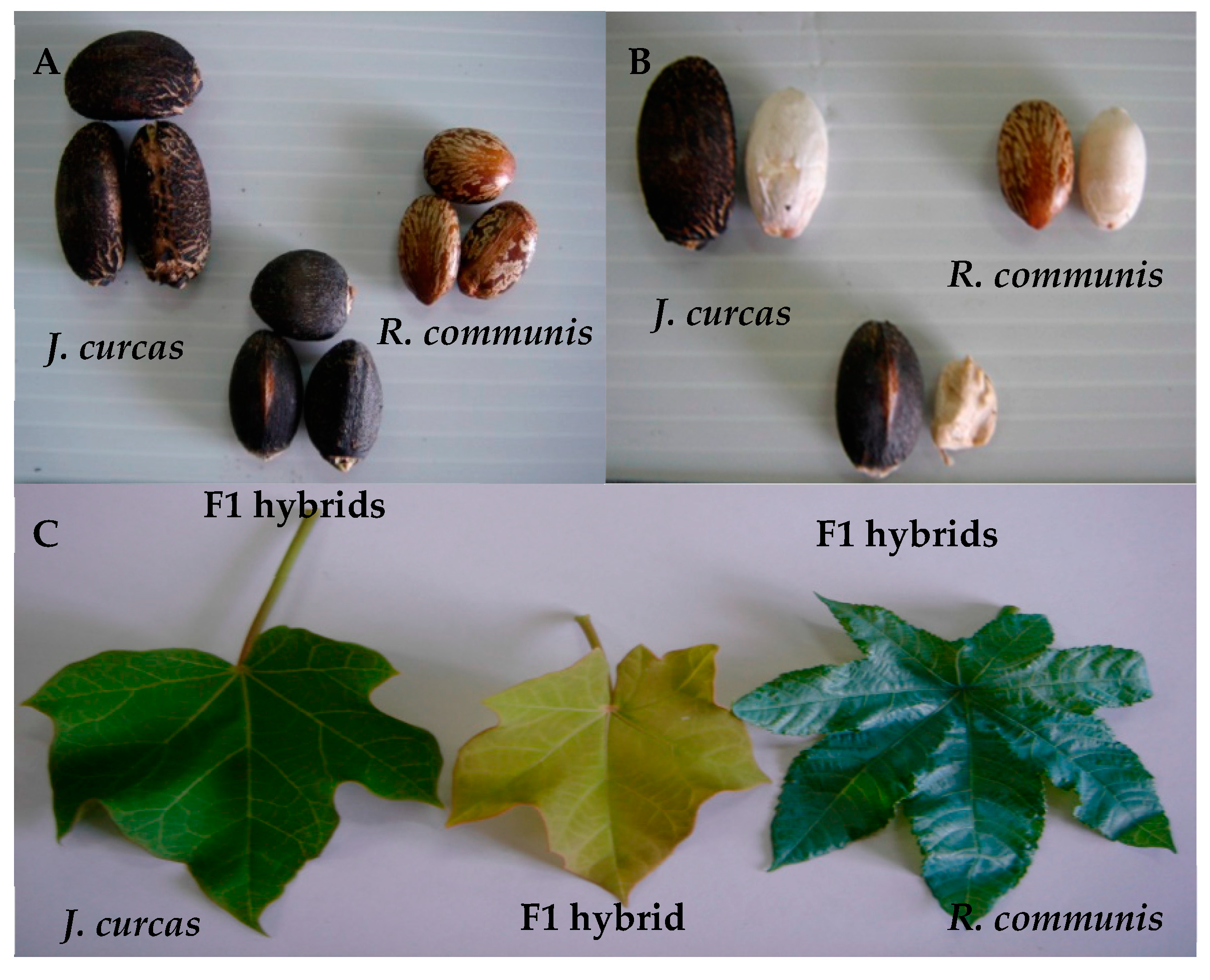

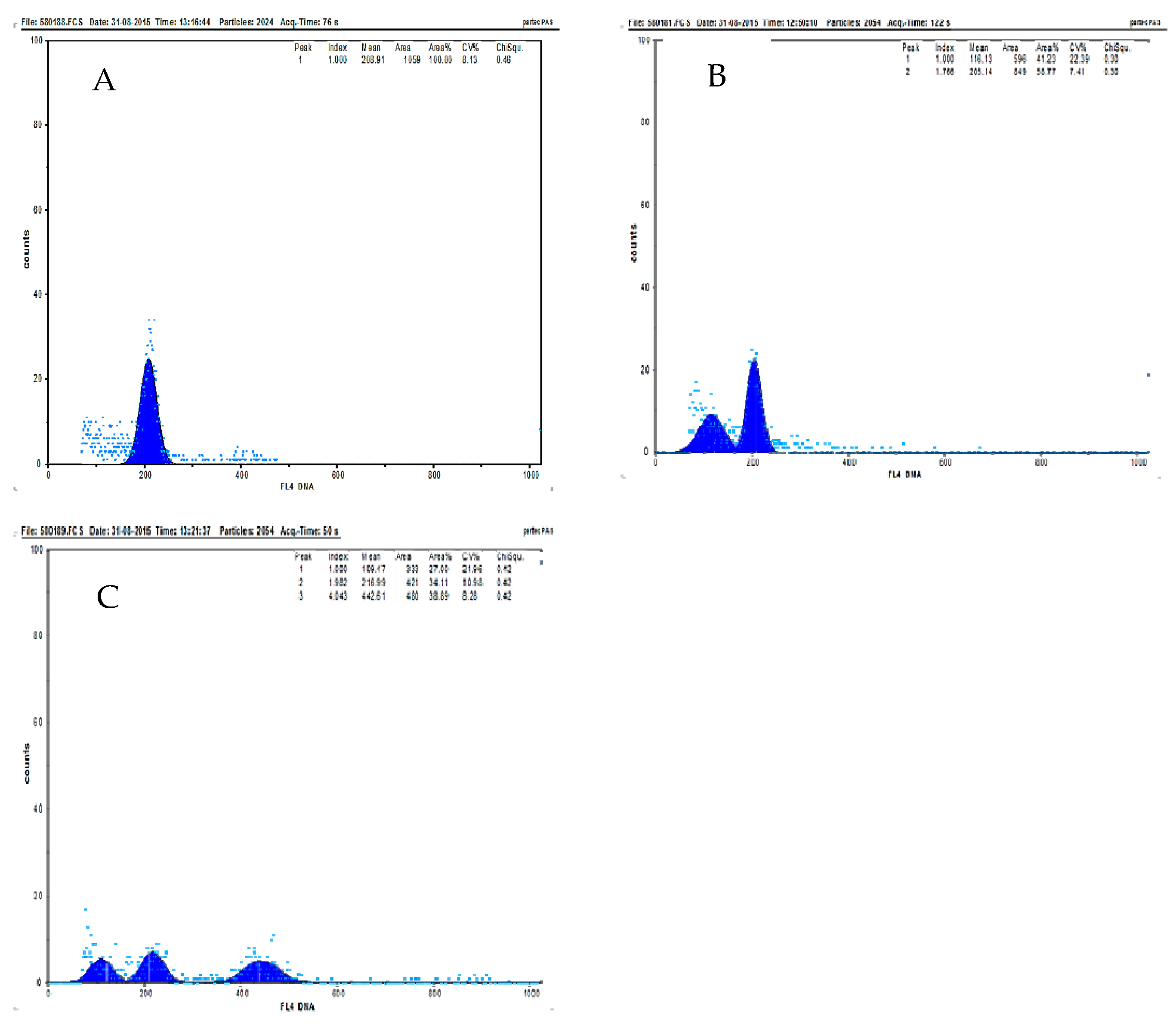
| Cross | Chemicals | Fruit Set (%) | Seed Set (%) | Seed Length (mm) | Seed Width (mm) | Seed Weight (g) | Seedling Survival (%) |
|---|---|---|---|---|---|---|---|
| JC | Control | 100 | 93 | 18.79 ± 0.16 | 11.26 ± 0.07 | 1.14 ± 0.10 | 100 |
| JC × RC | GA3 25 mg/L | 15 | 83 | 25.07 ± 1.00 | 28.13 ± 0.82 | 1.00 ± 0.07 | 10 |
| GA3 50 mg/L | 20 | 83 | 27.59 ± 0.31 | 30.37 ± 0.80 | 1.04 ± 0.06 | 80 | |
| NAA 25 mg/L | 12.5 | 66 | 27.13 ± 1.37 | 24.06 ± 1.00 | 1.10 ± 0.00 | 0 | |
| NAA 50 mg/L | 0 | - | - | - | - | - | |
| Calcium–boron 0.1% (v/v) | 40 | 83 | 25.00 ± 2.09 | 27.28 ± 0.62 | 0.94 ± 0.06 | 100 | |
| Calcium–boron 0.2% (v/v) | 0 | - | - | - | - | - | |
| RC | Control | 76 | 4 | 16.41 ± 0.50 | 18.36 ± 0.51 | 0.20 ± 0.09 | 63 |
| RC × JC | GA3 25 mg/L | 4 | 56 | 8.88 ± 0.72 | 6.01 ± 0.15 | 0.03 ± 0.01 | EB |
| GA3 50 mg/L | 0 | - | - | - | - | - | |
| NAA 25 mg/L | 3 | 66 | 9.34 ± 1.42 | 6.24 ± 0.85 | 0.04 ± 0.01 | EB | |
| NAA 50 mg/L | 0 | - | - | - | - | - | |
| Calcium–boron 0.1% (v/v) | 8 | 24 | 13.70 ± 0.61 | 12.84 ± 1.49 | 0.12 ± 0.06 | EB | |
| Calcium–boron 0.2% (v/v) | 31 | 9 | 13.37 ± 0.17 | 12.35 ± 0.51 | 0.24 ± 0.03 | EB |
| Characters | J. curcas L. | R. communis L. | Intergeneric Hybrids |
|---|---|---|---|
| Plant height (mm) | 2070.33 ± 11.14 a | 1630.00 ± 6.54 b | 1620.00 ± 4.54 b |
| No. of branches per plant | 4.00 ± 0.28 a | 3.00 ± 0.19 b | 4.67 ± 0.38 a |
| No. of female flowers | 9.00 ± 0.53 b | 34.00 ± 0.98 a | 0.50 ± 0.05 c |
| No. of male flowers | 144.00 ± 5.25 a | 128.50 ± 4.55 b | 30.00 ± 1.24 c |
| Stem diameter (mm) | 280.67 ± 0.50 a | 90.00 ± 0.35 b | 280.33 ± 0.53 a |
| Leaf size length (mm) | 100.17 ± 0.47 b | 190.30 ± 0.69 a | 98.80 ± 0.41 b |
| Leaf size width (mm) | 110.43 ± 0.68 b | 230.00 ± 0.45 a | 110.67 ± 0.76 b |
| Callus | Colchicine (%) | Treatment Time (Days) | Peak 1 (% Area) | Peak 2 (% Area) | Peak 3 (% Area) |
|---|---|---|---|---|---|
| JR1 | 0 | 3 | 100 | - | - |
| 0 | 7 | 18.64 | 71.10 | 10.25 | |
| 0.3 | 3 | 26.91 | 44.20 | 28.89 | |
| 0.3 | 7 | 39.40 | 38.48 | 22.12 | |
| 0.4 | 3 | 32.24 | 47.77 | 20.00 | |
| 0.5 | 3 | 38.12 | 44.20 | 17.68 | |
| JR6 | 0 | 3 | 100 | - | - |
| 0.3 | 3 | 27.00 | 34.11 | 38.89 | |
| 0.4 | 3 | 59.37 | 24.12 | 16.51 | |
| 0.5 * | 3 | - | - | - |
© 2019 by the authors. Licensee MDPI, Basel, Switzerland. This article is an open access article distributed under the terms and conditions of the Creative Commons Attribution (CC BY) license (http://creativecommons.org/licenses/by/4.0/).
Share and Cite
Premjet, D.; Obeng, A.K.; Kongbangkerd, A.; Premjet, S. Intergeneric Hybrid from Jatropha curcas L. and Ricinus communis L.: Characterization and Polyploid Induction. Biology 2019, 8, 50. https://doi.org/10.3390/biology8020050
Premjet D, Obeng AK, Kongbangkerd A, Premjet S. Intergeneric Hybrid from Jatropha curcas L. and Ricinus communis L.: Characterization and Polyploid Induction. Biology. 2019; 8(2):50. https://doi.org/10.3390/biology8020050
Chicago/Turabian StylePremjet, Duangporn, Abraham Kusi Obeng, Anupan Kongbangkerd, and Siripong Premjet. 2019. "Intergeneric Hybrid from Jatropha curcas L. and Ricinus communis L.: Characterization and Polyploid Induction" Biology 8, no. 2: 50. https://doi.org/10.3390/biology8020050
APA StylePremjet, D., Obeng, A. K., Kongbangkerd, A., & Premjet, S. (2019). Intergeneric Hybrid from Jatropha curcas L. and Ricinus communis L.: Characterization and Polyploid Induction. Biology, 8(2), 50. https://doi.org/10.3390/biology8020050





